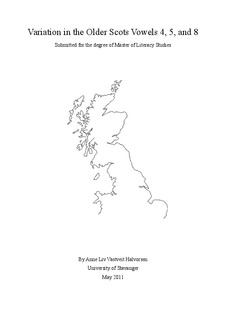| dc.description.abstract | The present thesis is a study of the Older Scots vowels 4, 5, and 8, as classified in A.J. Aitken’s vowel system, in the period 1380-1500. The vowels are studied based on a number of lexical items containing the various vowels: MAKE pt, MORE, NAME, and STONE with Vowel 4; DAUGHTER, GOD, OVER, and WOULD with Vowel 5; and MAY, THEY, and SAY pt with Vowel 8. These items have been extracted from the corpus of the Linguistic Atlas of Older Scots (Williamson 2008a), and that of the Middle English Grammar project (Stenroos, Mäkinen, Horobin, Smith 2008). These data are geographically mapped and divided into two time-periods in order to study their diatopic variation. Vowels 4, 5, and 8 are reflexes of the Old English vowels ā, ō and ǣ.
These vowels are known to have developed differently in the north and south of England and it is thus of interest to map their development also in Older Scots. The focus on Older Scots raises the question of Scots’ distinctness from Northern Middle English, the variety in use south of the border in the same time-period. It is thus of interest to study the similarities and dissimilarities between these two varieties.
Older Scots has generally received less attention compared to the variety found south of the border. This comparative neglect is being rectified through the compilation of the Linguistic Atlas of Older Scots and its related studies. This thesis thus contributes to the study of the vowel development of Older Scots and the sound changes affecting Scots. The thesis also shows spatial and diachronic dialect variation within Scotland based on the three vowels. Finally the thesis contributes the study of more lexical items to the Linguistic Atlas of Older Scots and the Middle English Grammar project.
The thesis is divided into three parts, 1) the introductory chapter, containing the historical and linguistic background to Older Scots, earlier and related studies and a description of the status of Scots in the period under study; 2) the data chapters, including the methodology used for the study and a presentation of the collected data in the form of geographic maps; and 3) the analysis of the data, which includes remarks on the quality of the data, a discussion of their implications and concluding remarks. | en_US |
